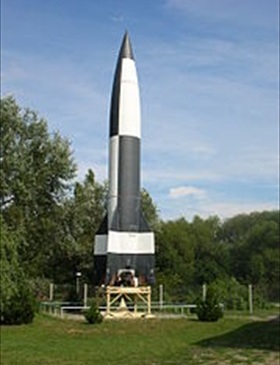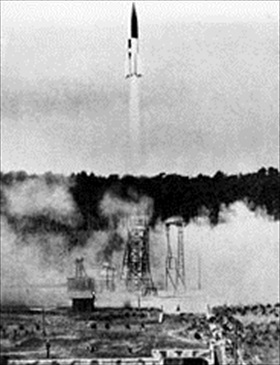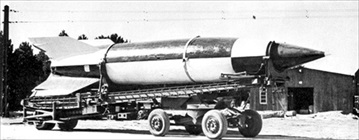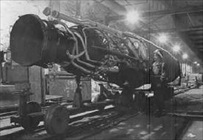FIRST LIQUID-FUEL ROCKET LAUNCHED
Auburn, Massachusetts · March 16, 1926
On this date in 1926 in Auburn, Massachusetts, Dr. Robert Goddard (1882–1945) conducted his first successful rocket flight. His liquid-propellant rocket rose 41 ft, traveled 184 ft, and burned no more than 3 seconds, but it proved the concept of rocket flight worked. Goddard, who received limited support for his research and development work (and quite a bit of ridicule from sceptics), was among a handful of rocket enthusiasts in the Soviet Union (Russia), France, the U.S, and Germany. German amateur rocketry enthusiasts, among them a young Wernher von Braun, began testing rockets at what was once Berlin’s Tegel Airport. Because rockets were not addressed in the 1919 Treaty of Versailles, which demilitarized post-World War I Germany, they attracted in the early thirties, perhaps quite naturally, the attention of the German army, which allowed doctoral candidate von Braun to use its proving grounds to conduct experiments on rocket propulsion. As Adolf Hitler’s Nazi Germany began to move to a warlike posture in the late 1930s, von Braun became a professional rocket developer. (He also became a Nazi Party member and an SS major.) It was under von Braun’s direction that the most destructive weapon of the European theater, the V‑2 combat rocket, was developed at Peenemuende, a secretive site on the German Baltic coast. The Vergeltungswaffe 2 (retaliation weapon 2) was a single-stage, liquid-fuel ballistic missile produced in two damp, cold, poorly ventilated underground facilities by as many as 60,000 prisoners from Mittelbau-Dora, the concentration camp in eastern Germany where an estimated 20,000 prisoners died. (Mittelbau-Dora, also known as Nordhausen-Dora, was a subcamp of the Buchenwald concentration camp.) From September 1944 to early 1945, V‑2 launch teams fired more than 3,200 V‑2 rockets, each with a high-explosive, one-ton warhead, at targets in England, France, Belgium, Holland, and even inside Germany itself—at Remagen, whose bridge over the Rhine River had recently been captured intact by the U.S. 9th Armored Division. Many rockets were launched from mobile platforms in urban areas and concealed forests, using fleets of specially built transporters (“Meillerwagen”) and sophisticated support vehicles. The V‑2 had no effect on the outcome of the war; its value as a weapon of terror and mass destruction lay in its novelty.
[amazon_carousel widget_type=”ASINList” width=”600″ height=”200″ title=”Recommended Reading” market_place=”US” shuffle_products=”False” show_border=”False” asin=”052128340X,0307389375,0955597757,067477650X,1602397058,1594160120,0811733874,0764324527,156663511X,1408702932″ /]
V-2 Short-Range Ballistic Missile
 |  |
Left: A V‑2 rocket in the Peenemuende Museum. RAF air raids on Peenemuende’s V‑2 research and production facilities caused the Germans to move production to the Mittelwerk location inside the Harz Mountains of Thueringen (Thuringia), eastern Germany, where slave labor built 5,200 V‑2 rockets in cold, dank underground caverns and tunnels without running water or proper sanitation. Wernher von Braun admitted occasionally visiting the Mittelwerk rocket factory (but not the notorious Mittelbau-Dora concentration camp that provided the factory with its labor), and called conditions there “repulsive.”
![]()
Right: A V‑2 test rocket four seconds after liftoff at Peenemuende, June 21, 1943. The V‑2 (its technical name was A4) is perhaps the only weapon system to have caused more deaths (12,000–20,000 forced laborers and concentration camp prisoners) by its production than by its deployment (an estimated 9,000 civilians and military personnel).
 |  |
Left: A V‑2 rocket on a Meillerwagen transport trailer near Cuxhaven on the North German coast in 1945. Meillerwagen were one of several vehicles in a V‑2 launch battery. It brought the V‑2 to its launch site, mounted the missile on its firing stand, and served as the service gantry for fuelling and launch preparation. Meillerwagen were assembled using Italian and Soviet prison laborers some 16 miles south of the Rhine city of Bonn in former railway tunnels below vineyards and forests along the Ahr River.
![]()
Right: A V‑2 propulsion unit on a dolly inside the underground assembly facility at Niedersachswerfen near Nordhausen, Germany. About 250 V‑2 missiles were found in various stages of completion on the Mittelwerk assembly line after the war, when this photo was taken.
Footage of Peenemuende Army Research Center and Dr. Wernher von Braun, the Site’s Technical Director
![]()

 History buffs, there is good news! The Daily Chronicles of World War II is now available as an ebook for $4.99 on Amazon.com. Containing a year’s worth of dated entries from this website, the ebook brings the story of this tumultuous era to life in a compelling, authoritative, and succinct manner. Featuring inventive navigation aids, the ebook enables readers to instantly move forward or backward by month and date to different dated entries. Simple and elegant! Click
History buffs, there is good news! The Daily Chronicles of World War II is now available as an ebook for $4.99 on Amazon.com. Containing a year’s worth of dated entries from this website, the ebook brings the story of this tumultuous era to life in a compelling, authoritative, and succinct manner. Featuring inventive navigation aids, the ebook enables readers to instantly move forward or backward by month and date to different dated entries. Simple and elegant! Click 











